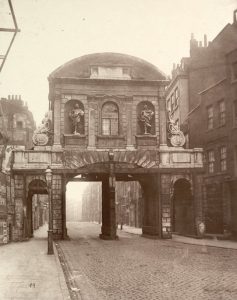 Temple Bar in 1880
Temple Bar in 1880
The photograph shows the west side of Temple Bar as it was a short time before its dismantlement shored up with timber to counteract the effects of the excavations for the New Law Courts.
Temple Bar was the principal ceremonial entrance to the City of London on its western side from the City of Westminster. It is situated on the historic royal ceremonial route from the Tower of London to the Palace of Westminster, the two chief residences of the mediaeval English monarchs, and from the Palace of Westminster to St Paul’s Cathedral.
The road east of Temple Bar and within the City is Fleet Street, the road to the west, in Westminster, is The Strand. At Temple Bar the Corporation of the City of London formerly erected a barrier to regulate trade into the City. The 19th century Royal Courts of Justice are located next to it on its north side, having been moved from Westminster Hall.
As the most important entrance to the City of London from Westminster, it was formerly long the custom for the monarch to halt at Temple Bar before entering the City of London, in order for the Lord Mayor to offer up the Corporation’s pearl-encrusted Sword of State as a token of loyalty. The term Temple Bar strictly refers to a notional bar or barrier across the route, but is commonly used to refer to the 17th century ornamental Baroque arched gateway designed by Christopher Wren which spanned the road until its removal in 1878.
Wren’s arch was preserved and was re-erected in 2004 in the City, in Paternoster Square next to St Paul’s Cathedral.
